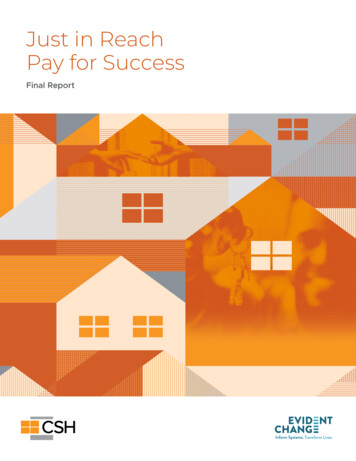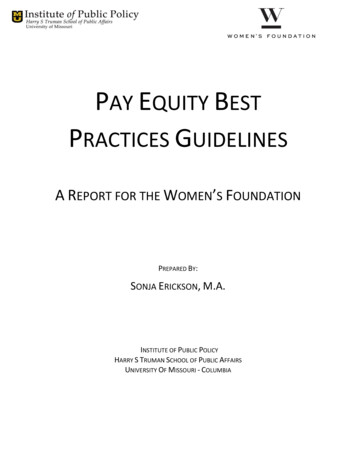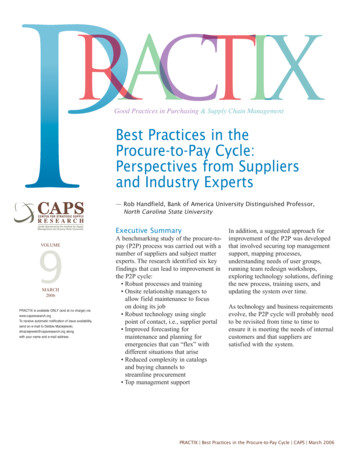
Transcription
Just in ReachPay for SuccessFinal Report
JUST I N R EAC H PAY FO R S UCC E S SAcknowledgmentCorporation for Supportive Housing (CSH)and Evident Change, in their capacityas co-intermediaries of the Just in ReachPay for Success (JIR PFS) project in LosAngeles, California, prepared this report.We would like to thank and acknowledge the projectstakeholders who made this initiative possible: Los Angeles County Department ofHealth Services (DHS) and the Officeand Urban Development (HUD)/of Diversion and Reentry (ODR)Department of Justice (DOJ) Pay Los Angeles County Sheriff’sDepartment (LASD) Conrad N. Hilton Foundation UnitedHealthcarefor Success Permanent SupportiveHousing Demonstration Programand the California Board of Stateand Community Corrections (BSCC)Pay for Success provided additional RAND Corporationgrant funding for this initiative. Intensive Case Management ServiceThe work that provided the basis(ICMS) providers: Amity Foundation,Special Services for Groups LLC(SSG), Telecare, The PeopleConcern, Volunteers of America Flexible Housing Subsidy PoolOperator: Brilliant Corners2The Department of HousingCSH.ORGfor this publication was supportedby funding under an award withthe U.S. Department of Housingand Urban Development. Thesubstance and findings of the workare dedicated to the public.
2021 F INAL REP ORTABOUT CSHCSH, the Corporation for Supportive Housing,is the national leader in supportive housing,focusing it on person-centered growth, recovery,and success that contributes to the health andwellbeing of the entire community. Our greatestasset is our team. From our Board of Directorsto staff, we work every day to build healthierpeople and communities. Through our consulting,training, policy, and lending, we advanceinnovation and help create quality supportivehousing. Our hub offices drive initiatives in 48states and more than 300 communities, whereCSH investments create thousands of homes andgenerate billions of dollars in economic activity.For more information, visit CSH.org.ABOUT EVIDENT CHANGEEvident Change is a nonprofit that uses dataand research to improve our social systems.At Evident Change, we believe our social systemsshould help people reach their greatest potential,not create barriers to their success. That’s whywe partner with systems professionals andcommunities to get to the root of their biggestchallenges, and we give them the tools andknowledge to achieve better outcomes foreveryone involved. Because when we join forceswith those who work in our systems and thepeople they serve, we make those systems—andour society—more equitable from the inside out.For more information, visit EvidentChange.org.CSH.OR G3
JUST I N R EAC H PAY FO R S UCC E S SExecutiveSummaryThese participants receivedThe project’s success wasservices from Intensive Casesufficient to fully repay theManagement Service (ICMS)amount provided by investorsproviders aligned with housingand yield a modest returnsubsidies to ease their transitionon their investment.from jail and reentry into thecommunity. The programfocused on two primaryobjectives for the participants:increasing their stay in homeslong term and reducingrecidivism. These measures werethe basis for success paymentsmade by Los Angeles Countyas part of the performancebased contract for the project.After four years of successfulprogram operations, JIR PFSaccomplished its objectives.4CSH .ORGThis report will provide anoverview of how the initiativecame together and discussits performance against thepayment-related outcomemeasures. In addition, RANDCorporation, the project’sevaluator, conducted an impactevaluation and cost analysis,including a quasi-experimentalassessment of the impacts andcost analysis of the program.Photo by Kindel Media on Pexels.The Just in Reach Pay for Success (JIR PFS)project used upfront funding from investors toprovide supportive housing to 349 individuals withdisabilities and histories of homelessness who wereexiting the Los Angeles County jail system.349The JIR PFS initiativesuccessfully connected349 individualswith homes.
2021 F INAL REP ORTKey Project SuccessesThe JIR PFS initiative had several critical successes duringthe project’s term. A few are highlighted here:Positive Outcomes for ParticipantsThe JIR PFS initiative successfully connected 349 individuals with homes. A highpercentage of these individuals remained in their homes for at least one year.Further, the initiative saw participants avoiding a return to jail at an even higherrate than was initially projected. These results are strong indicators of success,and reaffirm that providing people exiting jails with housing and supportiveservices can reduce their likelihood of interacting with the justice system.Continuous Quality ImprovementThe JIR PFS initiative had a committed group of stakeholders who met regularlythroughout the initiative to review data and performance. This structure providedstakeholders with timely data used to modify and improve programs in real-time.Strengthening the ModelBased on data from the JIR PFS initiative, ODR made various changes thatmay have contributed to an improvement in the project results, particularly the12-month housing stability rate during the time the program was operational.These changes included reducing staff-to-client ratios among the ICMS providersfrom 1:20 to 1:15, offering additional behavioral health services, bringing onmore ICMS providers, improving communications with the justice/jail system,and increasing the range of housing options available to participants.Navigating the COVID-19 PandemicA significant period of the initiative occurred during the COVID-19 pandemic.As a result, the ODR and ICMS providers adjusted practices to ensure client andstaff safety. As is further noted in the JIR PFS 2020 Annual Report, ODR quicklyadapted to safe practices based on newly updated COVID-19 response guidelines,which served clients across all ODR housing programs, including JIR PFS.CS H .ORG5
JUST I N R EAC H PAY FO R S UCC E S SThe ProblemLos Angeles Countyhas one of the largestjail systems in theUnited States.On any given night, the county jail holdsmore than 17,000 inmates1. The Los AngelesSheriff’s Department estimated in 2015that at least 20% of inmates experience17k Over 17,000 inmates are held in theLos Angeles County jail on any given night.20%It was estimated in 2015 that at least20% of inmates experience homelessnessupon reentry to their communities.homelessness or are at risk of homelessnessupon reentry to their communities. Echoingnational findings, data specific to Californiastrongly suggests that the population ofpeople held in jail who have a severe mentalillness (SMI) have higher recidivism ratesthan any other group, with an average of74% returning to custody within three years,compared to 50% for the general populationof individuals who previously exited jail.2Across the country, homelessness andrecidivism create a cycle of involvement withthe justice system that negatively affectsindividuals’ health and well-being. Peoplecaught in this cycle often are unshelteredfollowing release from jail and use crisis servicesat a higher rate. Further, they are often unableto access the affordable housing alignedwith supportive services that could providethem with stability and promote thriving.1 Million Dollar Hoods: Understanding the Largest JailSystem on Earth Challenge Inequality (ucla.edu)2 2013 California Department of Corrections andRehabilitation (CDCR) Outcome Evaluation Report.6CSH .ORG74%An average of 74% of individuals heldin jail with a severe mental illness returnto custody within three years.
2021 F INAL REP ORTThe SolutionIn 2015, partners in Los Angeles came together to develop a programmodeled on two existing local initiatives, Los Angeles County’s Housingfor Health (HFH) and the CSH Just in Reach program, to disrupt the costlyhomelessness-jail cycle. In July of that year, the Los Angeles CountyBoard of Supervisors approved the County CEO’s recommendationto prioritize this initiative as the county’s first PFS project.CSH.OR G7
JUST I N R EAC H PAY FO R S UCC E S SShortly after, in Septemberof 2015, ODR was createdby the Board of Supervisorsand placed within the LosAngeles County Departmentof Health Services. Itsmission is to “develop andimplement county-widecriminal justice diversion forpersons with mental and/or substance use disorders,to provide reentry supportservices based on individual’sneeds, and to reduce youthinvolvement with the justicesystem.”3 ODR began housingindividuals as part of thesediversion efforts in 2016.JIR PFS launched in 2017,aligning with and scaling upthe existing ODR housinginitiatives. Over four years,JIR PFS provided supportivehousing to more than 300 ofthe most vulnerable individualsin Los Angeles County jailswith histories of homelessnessand justice involvement whooften had no choice but toengage with high-cost publicsystems. JIR PFS set out toprovide supportive housing,increase housing stability,Funding StructurePay for Success seeks to achieve positive social andeconomic outcomes by combining a performance-basedcontract with upfront funding from impact investors. Theimpact investors provide the working capital neededto implement an intervention, like supportive housing,and are repaid based on the project’s overall success.Typically, these “success payments” are made bygovernment entities based on the value established inthe contract and placed on the observed outcomes.Ten million dollars in funding for JIR PFS came from upfrontcapital provided by private investors. The repayment dependson individual participants’ housing stability and jail outcomes.The project also leveraged additional funding from theDepartment of Housing and Urban Development (HUD)/Department of Justice (DOJ) Pay for Success PermanentSupportive Housing Demonstration Program (HUD-DOJ), andthe California Board of State Community Corrections (BSCC).and decrease returns toJIR PFS was one of the first projects to launch with the HUD-jail for these individuals.DOJ and California BSCC pay for success grant programs.3 y/8CSH .ORG
2021 F INAL REP ORTProjectStructureFigure 1. JIR PFS Project StructureFlow of funding andproject implementationPotential flow ofachieved outcomesand outcome paymentsFlow of evaluation dataB.The JIR PFS project structure andpartners are outlined in Table 1.Table 1. Project PartnersInvestorsConrad N. HiltonFoundation( 3M); UnitedHealthcare ( 7M)Other FundingPartnersHUD-DOJ;California BSCCIntermediariesCSH; EvidentChangeEnd PayerLos AngelesCountyRentalAssistanceand HousingNavigationServicesProviderBrilliant CornersICMSProvidersAmityFoundation;Special Servicesfor Groups (SSG);Telecare; ThePeople Concern;Volunteersof AmericaEvaluatorC.A.E.A. S ervice ProviderIntensive Case ManagementServices (ICMS) ProvidersC. Manages funding forrental assistanceto serve approximately 300individuals in supportivehousing in JIR PFS Monitors and calculatessuccess payments Staffs Executive Steering The project called for fourand Operations Committeesyears of service deliveryBrilliant Corners Provided housing navigationservices and rentalassistance to 300 individualsin supportive housing The project called for fouryears of service deliveryB. G overnmentLos Angeles County Agrees to repay investorsbased on outcomes basedon housing stability andqualifying returns to jail Co-IntermediaryCSH & Evident Change Contracted by LA CountyRental AssistanceProviderRANDCorporationD.D. InvestorsThe Hilton Foundationand United Healthcare Provided 10 millionin loan fundingE. E valuatorRAND Validates successpayment outcomes Determines differencebetween treatment andcontrol groups’ serviceutilization and costs Funds intensive casemanagement services (ICMS)Source: Adapted from GAO analysis of information provided by projectparticipants. GAO-15-646 and urban.org/research-area/pay-successCS H .ORG9
JUST I N R EAC H PAY FO R S UCC E S SProject ParticipantsIndividuals with histories of justice involvement andhomelessness were the beneficiaries of this initiative.More specifically, participants were referred by LA County to JIR PFS if:1. LocationThey were within the Los Angeles County criminal justice system;2. History of HomelessnessThey had experienced homelessness in the previous three years;3. VulnerabilitiesThey rated high on the Vulnerability Index & Service PrioritizationDecision Assistance Tool (VI-SPDAT) and;4. Contributing Health FactorsThey were diagnosed with one or more conditions, including:SMI, substance use disorder, developmental disability, post-traumaticstress disorder, cognitive impairment resulting from a brain injury,and/or a chronic physical illness or disability.10CSH .ORG
2021 F INAL REP ORTServices DeliveredThe ODR housing program, which includes the JIR PFSenrollees, supported participants on each step of theirjourney from jail to supportive and independent housing. Participants were identifiedas potential candidates forreceived ongoing supportiveODR housing while in jail.services from their ICMSIf they were found to beprovider including, buteligible and agreed to enroll,not limited to: enrollmentthey were then conditionallyin mainstream servicesreleased to ODR followingbenefits, connectiona suitability hearing.to mental health and While still in jail, theyconnected with an ICMSprovider under contractwith ODR. They also had ashort-term (interim) housingoption to have a place to goonce they were released. Brilliant Corners providedparticipants with housingnavigation services andadministered rentalassistance through theFlexible Housing SubsidyPool to help people identifyand choose the mostappropriate permanenthousing placement.4 ODR housing participantssubstance use treatmentservices, mentoring andother community support,and ongoing housingstabilization services.4 Eligible ODR housingparticipants who enteredpermanent supportivehousing could be “enrolled”in the JIR PFS initiative atthe point at which theyentered supportive housing.Each individual in JIR PFSreceived a custom treatment planwhich offered flexible servicestailored to meet their needs.https://www.rand.org/pubs/research reports/RRA1216-1.htmlCS H .ORG11
JUST I N R EAC H PAY FO R S UCC E S SParticipant DemographicsAt the end of four years, 349 individuals received housingas part of the JIR PFS initiative. Of the 349 individuals housedin the program, the average age was 43, 67% were male ,30% were female , and 3% were transgender. In addition,the group identified racially as described in figure 2.Figure 2: JIR PFS All Participants by Race, N 349Race/Ethnicity (Group)Numberof PersonsPercentageof PersonsAmerican Indian or Alaska Native30.9%Asian82.3%15945.6%Don’t l195.4%10.3%5816.6%349100%Black or African AmericanNative Hawaiian or Other Pacific IslanderWhite, Non-Hispanic/LatinoThis demographic breakdown reflects an overrepresentation of Black people as compared tothe population of Los Angeles County as a whole. Overrepresentation of Black people is alsoseen among the population of persons experiencing homelessness in Los Angeles and thosein the Los Angeles County jail in general and within the jail mental health population.5,65 tion-and-34-of-homeless-count-heres-why6 ounty-jail-mental-health-population/12CSH .ORG
2021 F INAL REP ORTSuccess PaymentsPFS initiatives have measures tied to outcomes that determine thepotential repayment to investors. These measures help to focus allproject partners on concrete and measurable indicators of success.In the JIR PFS initiative, Los Angeles County made payments basedon two key measures: housing stability and qualifying returns to jail.Payments were made based on enrolled individuals achievementof six months and twelve months of housing stability, and on thenumber of jail returns experienced by enrolled individuals duringtwo years post enrollment. Based on the level of success ofthe project, the project’s investors were repaid their 10 millioninvestment and earned approximately 2.9% in blended interest.Figure 3. Housing Stability Both positive and negative exits from housing were tracked in theproject as part of the overall definition of housing stability. Positiveexits included moving to other permanent housing and settingsdesigned to meet particular clinical needs, such as residential careor in-patient substance use treatment services. Participant deathswere also accounted for in this category as a neutral outcome. Negative exits included returns to jail, prison,interim housing or unknown destinations. While the aggregate 12-month housing stability rate waslower than the initial 90% projection, ODR’s housing programserves clients who have not previously had the opportunity tobe connected to supportive housing. They are also typicallynot connected to the mainstream homeless services systemdue to their acute health and/or mental health service needs.Furthermore, the primary source of data initially used to set thehousing retention rate was based on Housing for Health clients.In ODR’s experience, ODR supportive housing clients have moreclinically acute needs than the average Housing for Health client.92%*of persons housing through theJIR PFS initiative stayed housedfor at least 6 months.* Original projection, 92%78%**stayed housed for at least 12months. This rate increased overtime, with the final cohort at 86%.* Original projection, 90%CS H .ORG13
JUST I N R EAC H PAY FO R S UCC E S SFigure 4. Jail Avoidance (Qualifying Returns to Jail)Over 2 years .JIR PFS projected that over 2 years:JIR PFS actually found that:43% of people wouldhave zero returns to jail43%56% of people hadzero returns to jail22% of people wouldhave one return to jail22%21% of people hadone return to jail5% of people wouldhave two returns to jail5%8% of people hadtwo returns to jail20% of people would havethree or more returns to jail20%15% of people had threeor more returns to jail The project set baselines based upon data from the past performance ofsimilar individuals. These baseline assumptions were that 65% of participantswould have either zero or one returns to jail during the two-year evaluationperiod. The project beat this baseline level of performance, with 77% ofparticipants having zero or one return to jail during the evaluation period. This level of performance is noteworthy given that thispopulation was actively involved with the justice system.14CSH .ORG
2021 F INAL REP ORTConclusionThe Just in Reach Payfor Success Programsuccessfully helped thevast majority of 349people experiencinglong-term homelessnessand high service needsfind a stable home andavoid returns to jail.This initiative adds to the evidencebase within Los Angeles and acrossthe country, showing that supportivehousing improves outcomes for personswith histories of homelessness, justiceinvolvement, and disabilities. WhileJIR PFS is a small share of the overallODR housing program, it should serveas a case study to policymakers ofthe benefits of supportive housingfor this population. In addition, theexcellent results should be reasonenough to make supportive housingavailable to all who need it.CSH.OR G15
CSH.orgCopyright 2022 by CSH. All Rights Reserved.
on individual participants' housing stability and jail outcomes. The project also leveraged additional funding from the Department of Housing and Urban Development (HUD)/ Department of Justice (DOJ) Pay for Success Permanent Supportive Housing Demonstration Program (HUD-DOJ), and the California Board of State Community Corrections (BSCC).











